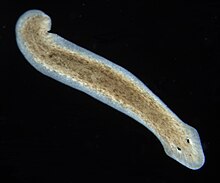| Dugesia subtentaculata | |
|---|---|

| |
| Asexual specimen of Dugesia subtentaculata | |
| Scientific classification | |
| Domain: | Eukaryota |
| Kingdom: | Animalia |
| Phylum: | Platyhelminthes |
| Order: | Tricladida |
| Family: | Dugesiidae |
| Genus: | Dugesia |
| Species: | D. subtentaculata
|
| Binomial name | |
| Dugesia subtentaculata (Draparnaud, 1801)
| |
| Synonyms | |
Dugesia subtentaculata is a species of planarian that inhabits the freshwater of Southern France, several localities on the Iberian Peninsula (including Catalonia), Mallorca, Morocco[4] and Algeria.[5]
In 1986 De Vries designated a neotype for D. subtentaculata after the original type material was lost. She also synonymized the species D. iberica, described from Mallorca and Iberian Peninsula, with D. subtentaculta. Both the neotype and the holotype are from the surroundings of Montpellier, from a locality where asexual specimens of D. subtentaculata and sexual individuals of D. gonocephala are found living together.[4]
- ^ Draparnaud, Jacques Philippe Raymond. Tableau des mollusques terrestres et fluviatiles de la France (in French), 1801.
- ^ Beauchamp, Paul de. «Sur une collection de Turbellariés d'eau douce (Triclades) du Maroc, rassemblée par Roberth Ph. Dollfus» (in French). Bulletin de la Société des Sciences Naturelles [et Physiques] du Maroc, 12, 1932, pp. 221-222.
- ^ Gourbault, Nicole; Benazzi, Mario «Une nouvelle espèce ibérique du 'groupe Dugesia gonocephala (Turbellariés, Triclades)» (in French). Bulletin du Muséum national d'histoire naturelle (Zoologie), 2, 1979, pp. 329-337.
- ^ a b Vries, Elizabeth J. De (1986). "On the taxonomic status of Dugesia gonocephala and Dugesia subtentaculata (Turbellaria, Tricladida, Paludicola)". Journal of Zoology. 209: 43. doi:10.1111/j.1469-7998.1986.tb03565.x.
- ^ Vries, E. J. (1988). "A synopsis of the nominal species of the subgenus Dugesia (Platyhelminthes: Tricladida: Paludicola) from Africa and Madagascar". Zoological Journal of the Linnean Society. 92 (4): 345–382. doi:10.1111/j.1096-3642.1988.tb01729.x.